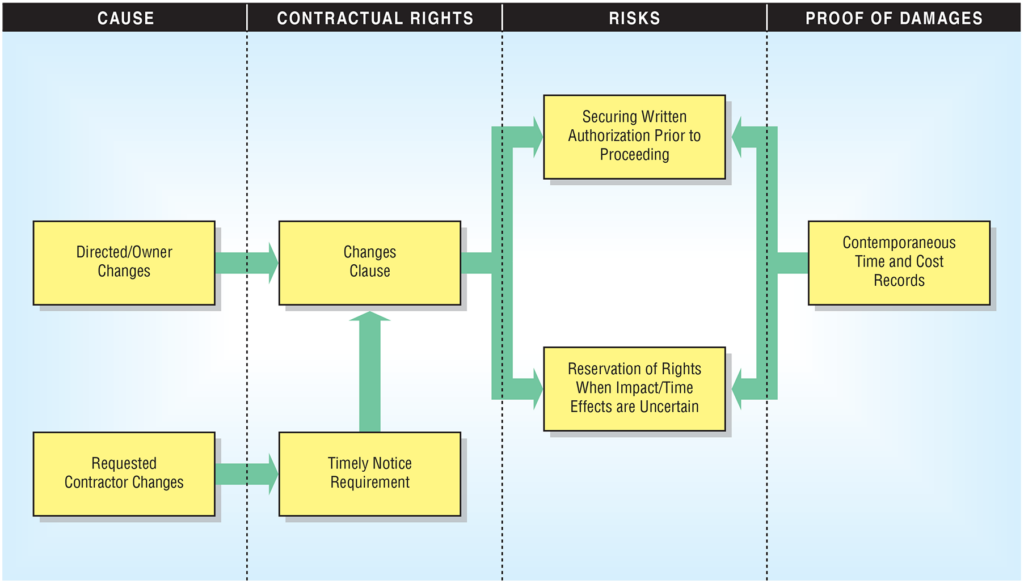
October 9, 2023
Directed Change: Changes Clauses and Disputes in Contracts
This is the first of two blog posts exploring directed change on construction projects. This post discusses changes clauses and common mistakes that lead to disputes. The second post will focus on failure to provide notice, failure to secure a written change order, and change order acceptance absent reservation of rights.
Directing performance of extra work on a construction project was once little more than a rudimentary task for the architect or resident engineer. Unfortunately, such simplicity is no longer the order of the day. Contractors and subcontractors alike are becoming increasingly reluctant to proceed with extra work without complete assurance that all direct and impact costs will be paid. Absent such assurance, they are insisting that the extra work proceed with the right to reimbursement for additional time and costs if warranted. Conversely, owners and architect/engineers are equally reluctant to direct additional work if the time and financial aspects are not firmly established. With such an atmosphere, the extra work/change order process in construction has become ripe for controversy. Figure 1 illustrates the directed change process.
Figure 1: Directed Change Process

Changes clauses typically require that change orders be written and notice be timely. In this process, the following common actions on construction projects frequently result in controversy and disputes:
- The contractor fails to notify the owner that the work is considered “extra.”
- The contractor fails to secure a change order in writing to cover the “extra work.”
- The contractor accepts a change order without reservation of rights for additional time or impact costs.
Changes Clauses
In any construction project, various changes in circumstances or conditions can arise that the original contract documents do not cover; changes such as: (1) errors and omissions in plans and specifications; (2) changes instituted by regulatory agencies; (3) minor design changes; (4) overruns or underruns in quantities; and (5) factors affecting time of completion or the method or manner of performance of the work.
A “change” is an alteration to the contract work involving work already required to be done. In contracts, an “extra” involves additional items of work that are not included in the original contract. Both changes and extras give rise to modifications to the contract.
The pervasiveness of changes in the construction process has not been lost on drafters of construction contracts. Virtually all such contracts executed today, including the popular and commonly used general conditions promulgated by The American Institute of Architects, standard construction contracts offered by the Associated General Contractors and the United States government, as well as private construction contracts, contemplate the occurrence of changes and set forth procedures to implement them by including some form of changes clause.
Typically the changes clause of a contract establishes a formal procedure resulting in a written amendment to the contract that describes the precise nature of the new and different work that will be performed and the compensation to be made. The process is often triggered by a “design change request” or similar communication from the engineer, notifying the contractor of the requirement for a change to the design. The design change request should define, detail, and explain the new and different work to be performed and request a cost proposal for performing that work. The contractor is expected to respond promptly with a lump-sum proposal, covering the work of the contractor and its subcontractors (including appropriate and applicable mark-ups for profit and overhead), and a request for any required time extension. The change order clause in question will probably provide for compensation based on agreed-upon unit prices, if applicable to the work, or “time and material,” if desired by the owner, in which case an estimate or proposal may not be required from the contractor.
The benefit of having a changes clause in the contract is that it allows for greater flexibility by permitting changes without necessitating a new contract for each addition, deletion, or revision on a project. The changes clause also allows for adjustment of plans and specifications to clarify the work that the design professional and owner intend the contractor to perform without breaking contractual requirements. The change order mechanism also encourages the contractor to suggest beneficial changes, knowing that it may receive a price adjustment for additional work performed.
By effectively using this clause, owners (and contractors) can meet unforeseen contingencies without risking a breach of contract or being required to renegotiate a new contract. However, the owner’s right to modify the contract is subject to two significant limitations: (1) the modification should not fundamentally change the contract; and (2) the contractor must be compensated if the modification affects its costs or schedule or both.
Changes clauses also have the effect of reducing contingencies in competitive bidding and thus decreasing the overall cost to the owner.
Generally, contracts may not be modified without the consent of all parties. However, changes clauses in the contract may authorize one party, the owner, to modify the contract as needed to meet changing circumstances during the performance of the contract. The owner’s right to make changes or order extras will be governed by the wording of the particular clause and the law of the state or country where the contract is executed.
While most changes clauses allow the owner or its representative to initiate a change without the consent of the contractor, a change order generally must be in writing and must be within the general scope of the contract to prevent it from being designated a “cardinal change.”
ADDITIONAL RESOURCES

Blog
Discover industry insights on construction disputes and claims, project management, risk analysis, and more.
MORE

Articles
Articles by our engineering and construction claims experts cover topics ranging from acceleration to why claims occur.
MORE

Publications
We are committed to sharing industry knowledge through publication of our books and presentations.
MORE
RECOMMENDED READS
Constructive Changes
This post explores constructive changes, which are a common cause of construction claims, and problems establishing entitlement.
READ
Cardinal Change
The determination of what constitutes a cardinal change depends upon a court or arbitration panel decision and the unique contract language at issue.
READ
Definitions of Construction Claim Types for Contractors
This post summarizes the definitions of the 19 construction claim types that may apply to a contractor’s and subcontractor’s recovery of time and costs.
READ

